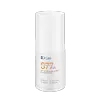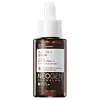What's inside
What's inside
 Key Ingredients
Key Ingredients

 Benefits
Benefits

 Concerns
Concerns

 Ingredients Side-by-side
Ingredients Side-by-side

Water
Skin ConditioningDipropylene Glycol
HumectantMethyl Gluceth-20
HumectantDimethicone
EmollientButylene Glycol
HumectantPhenoxyethanol
PreservativeCorallina Officinalis Extract
Skin ConditioningGlycerin
Humectant1,2-Hexanediol
Skin ConditioningAmmonium Acryloyldimethyltaurate/Vp Copolymer
Niacinamide
SmoothingHydroxyacetophenone
Antioxidant1-Methylhydantoin-2-Imide
Skin ConditioningPropanediol
SolventCarbomer
Emulsion StabilisingTromethamine
BufferingSodium Polyacryloyldimethyl Taurate
Emulsion StabilisingPolyacrylate Crosspolymer-6
Emulsion StabilisingEthylhexylglycerin
Skin ConditioningArginine Ferulate
Skin ConditioningPentylene Glycol
Skin ConditioningPaeonia Albiflora Root Extract
Skin ConditioningDisodium EDTA
Phaeodactylum Tricornutum Extract
HumectantPEG-40 Hydrogenated Castor Oil
EmulsifyingLecithin
EmollientSteareth-20
CleansingTremella Fuciformis Extract
HumectantHydrogenated Lecithin
EmulsifyingSodium Hyaluronate
HumectantTrideceth-9
EmulsifyingSodium Ascorbate
AntioxidantMagnolia Sieboldii Extract
Skin ConditioningTripeptide-1
Skin ConditioningCeramide NP
Skin ConditioningSclareolide
MaskingPropylene Glycol
HumectantPhenylethyl Resorcinol
AntioxidantParfum
MaskingUndecylenoyl Phenylalanine
Skin ConditioningMannitol
HumectantAcetyl Tetrapeptide-9
Skin ConditioningHexapeptide-9
Skin ConditioningGlabridin
BleachingTocopherol
AntioxidantPalmitoyl Pentapeptide-4
Skin ConditioningAcetyl Hexapeptide-8
HumectantPalmitoyl Tetrapeptide-7
Skin ConditioningCitric Acid
BufferingCeramide As
Skin ConditioningCeramide Ns
Skin ConditioningErgothioneine
AntioxidantSilica
AbrasiveCeramide AP
Skin ConditioningCeramide EOP
Skin ConditioningWater, Dipropylene Glycol, Methyl Gluceth-20, Dimethicone, Butylene Glycol, Phenoxyethanol, Corallina Officinalis Extract, Glycerin, 1,2-Hexanediol, Ammonium Acryloyldimethyltaurate/Vp Copolymer, Niacinamide, Hydroxyacetophenone, 1-Methylhydantoin-2-Imide, Propanediol, Carbomer, Tromethamine, Sodium Polyacryloyldimethyl Taurate, Polyacrylate Crosspolymer-6, Ethylhexylglycerin, Arginine Ferulate, Pentylene Glycol, Paeonia Albiflora Root Extract, Disodium EDTA, Phaeodactylum Tricornutum Extract, PEG-40 Hydrogenated Castor Oil, Lecithin, Steareth-20, Tremella Fuciformis Extract, Hydrogenated Lecithin, Sodium Hyaluronate, Trideceth-9, Sodium Ascorbate, Magnolia Sieboldii Extract, Tripeptide-1, Ceramide NP, Sclareolide, Propylene Glycol, Phenylethyl Resorcinol, Parfum, Undecylenoyl Phenylalanine, Mannitol, Acetyl Tetrapeptide-9, Hexapeptide-9, Glabridin, Tocopherol, Palmitoyl Pentapeptide-4, Acetyl Hexapeptide-8, Palmitoyl Tetrapeptide-7, Citric Acid, Ceramide As, Ceramide Ns, Ergothioneine, Silica, Ceramide AP, Ceramide EOP
Water
Skin ConditioningSodium Ascorbyl Phosphate 10%
AntioxidantIsopentyldiol
Humectant1,2-Hexanediol
Skin ConditioningNiacinamide
SmoothingDipropylene Glycol
HumectantButylene Glycol
HumectantMalpighia Emarginata Fruit Extract
Skin ConditioningCitrus Unshiu Peel Extract
MaskingCitrus Aurantifolia Fruit Extract
Skin ConditioningCitrus Limon Fruit Extract
MaskingBrassica Oleracea Italica Extract
AstringentHippophae Rhamnoides Extract
MaskingCitrus Aurantium Dulcis Fruit Extract
MaskingCitrus Paradisi Fruit Extract
Skin ConditioningAscorbic Acid
AntioxidantCitric Acid
BufferingOctyldodeceth-16
EmulsifyingXanthan Gum
EmulsifyingCitrus Aurantium Bergamia Fruit Oil
MaskingSodium Metabisulfite
AntioxidantEthylhexylglycerin
Skin ConditioningCoptis Japonica Extract
AntimicrobialDextrin
AbsorbentTheobroma Cacao Extract
Skin ConditioningSodium Hyaluronate
HumectantTocopheryl Acetate
AntioxidantPanthenol
Skin ConditioningDisodium EDTA
Limonene
PerfumingLinalool
PerfumingWater, Sodium Ascorbyl Phosphate 10%, Isopentyldiol, 1,2-Hexanediol, Niacinamide, Dipropylene Glycol, Butylene Glycol, Malpighia Emarginata Fruit Extract, Citrus Unshiu Peel Extract, Citrus Aurantifolia Fruit Extract, Citrus Limon Fruit Extract, Brassica Oleracea Italica Extract, Hippophae Rhamnoides Extract, Citrus Aurantium Dulcis Fruit Extract, Citrus Paradisi Fruit Extract, Ascorbic Acid, Citric Acid, Octyldodeceth-16, Xanthan Gum, Citrus Aurantium Bergamia Fruit Oil, Sodium Metabisulfite, Ethylhexylglycerin, Coptis Japonica Extract, Dextrin, Theobroma Cacao Extract, Sodium Hyaluronate, Tocopheryl Acetate, Panthenol, Disodium EDTA, Limonene, Linalool
 Reviews
Reviews

Ingredients Explained
These ingredients are found in both products.
Ingredients higher up in an ingredient list are typically present in a larger amount.
1,2-Hexanediol is a synthetic liquid and another multi-functional powerhouse.
It is a:
- Humectant, drawing moisture into the skin
- Emollient, helping to soften skin
- Solvent, dispersing and stabilizing formulas
- Preservative booster, enhancing the antimicrobial activity of other preservatives
Butylene Glycol (or BG) is used within cosmetic products for a few different reasons:
Overall, Butylene Glycol is a safe and well-rounded ingredient that works well with other ingredients.
Though this ingredient works well with most skin types, some people with sensitive skin may experience a reaction such as allergic rashes, closed comedones, or itchiness.
Learn more about Butylene GlycolCitric Acid is an alpha hydroxy acid (AHA) naturally found in citrus fruits like oranges, lemons, and limes.
Like other AHAs, citric acid can exfoliate skin by breaking down the bonds that hold dead skin cells together. This helps reveal smoother and brighter skin underneath.
However, this exfoliating effect only happens at high concentrations (20%) which can be hard to find in cosmetic products.
Due to this, citric acid is usually included in small amounts as a pH adjuster. This helps keep products slightly more acidic and compatible with skin's natural pH.
In skincare formulas, citric acid can:
While it can provide some skin benefits, research shows lactic acid and glycolic acid are generally more effective and less irritating exfoliants.
Most citric acid used in skincare today is made by fermenting sugars (usually from molasses). This synthetic version is identical to the natural citrus form but easier to stabilize and use in formulations.
Read more about some other popular AHA's here:
Learn more about Citric AcidDipropylene Glycol is a synthetically created humectant, stabilizer, and solvent.
This ingredient helps:
Dipropylene glycol is technically an alcohol, but it belongs to the glycol family (often considered part of the ‘good’ alcohols). This means it is hydrating and gentle on skin unlike drying solvent alcohols like denatured alcohol.
As a masking agent, Dipropylene Glycol can be used to cover the smell of other ingredients. However, it does not have a scent.
Studies show Dipropylene Glycol is considered safe to use in skincare.
Learn more about Dipropylene GlycolDisodium EDTA plays a role in making products more stable by aiding other preservatives.
It is a chelating agent, meaning it neutralizes metal ions that may be found in a product.
Disodium EDTA is a salt of edetic acid and is found to be safe in cosmetic ingredients.
Learn more about Disodium EDTAEthylhexylglycerin (we can't pronounce this either) is commonly used as a preservative and skin softener. It is derived from glyceryl.
You might see Ethylhexylglycerin often paired with other preservatives such as phenoxyethanol. Ethylhexylglycerin has been found to increase the effectiveness of these other preservatives.
Niacinamide is a multitasking form of vitamin B3 that strengthens the skin barrier, reduces pores and dark spots, regulates oil, and improves signs of aging.
And the best part? It's gentle and well-tolerated by most skin types, including sensitive and reactive skin.
You might have heard of "niacin flush", or the reddening of skin that causes itchiness. Niacinamide has not been found to cause this.
In very rare cases, some individuals may not be able to tolerate niacinamide at all or experience an allergic reaction to it.
If you are experiencing flaking, irritation, and dryness with this ingredient, be sure to double check all your products as this ingredient can be found in all categories of skincare.
When incorporating niacinamide into your routine, look out for concentration amounts. Typically, 5% niacinamide provides benefits such as fading dark spots. However, if you have sensitive skin, it is better to begin with a smaller concentration.
When you apply niacinamide to your skin, your body converts it into nicotinamide adenine dinucleotide (NAD). NAD is an essential coenzyme that is already found in your cells as "fuel" and powers countless biological processes.
In your skin, NAD helps repair cell damage, produce new healthy cells, support collagen production, strengthen the skin barrier, and fight environmental stressors (like UV and pollution).
Our natural NAD levels start to decline with age, leading to slower skin repair, visible aging, and a weaker skin barrier. By providing your skin niacinamide, you're recharging your skin's NAD levels. This leads to stronger, healthier, and younger looking skin.
Another name for vitamin B3 is nicotinamide. This vitamin is water-soluble and our bodies don't store it. We obtain Vitamin B3 from either food or skincare. Meat, fish, wheat, yeast, and leafy greens contain vitamin B3.
The type of niacinamide used in skincare is synthetically created.
Learn more about NiacinamideSodium Hyaluronate is hyaluronic acid's salt form. It is commonly derived from the sodium salt of hyaluronic acid.
Like hyaluronic acid, it is great at holding water and acts as a humectant. This makes it a great skin hydrating ingredient.
Sodium Hyaluronate is naturally occurring in our bodies and is mostly found in eye fluid and joints.
These are some other common types of Hyaluronic Acid:
Learn more about Sodium HyaluronateWater. It's the most common cosmetic ingredient of all. You'll usually see it at the top of ingredient lists, meaning that it makes up the largest part of the product.
So why is it so popular? Water most often acts as a solvent - this means that it helps dissolve other ingredients into the formulation.
You'll also recognize water as that liquid we all need to stay alive. If you see this, drink a glass of water. Stay hydrated!
Learn more about Water